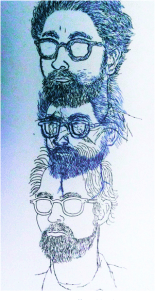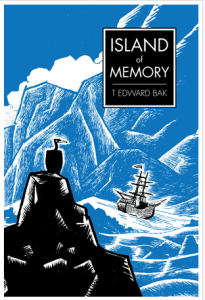The New York Comics & Picture-Story Symposium is a weekly forum for discussing the tradition and future of text/image work. Open to the public, it meets Monday nights at 7-9 p.m. EST in New York City.
Presentations vary weekly and include everything from historical topics and technical demonstrations to creators presenting their work. Check out upcoming meetings here.
Todd Edward Bak is a cartoonist and a native of Colorado, who now lives in Portland but wanders the United States. He’s interested in travel and the process of research and memory.
His lecture is part of an ongoing North American tour to promote his research,his book Island of Memory, and WILD MAN – The Natural History of Georg Wilhelm Steller, a book series.
When he lived in Athens, Georgia, Bak interested in comics deepened. A local comic shop owner became a guru of sorts for Bak. He was encouraged to read more autobiographical comics, which eventually inspired him to create one. From there, Bak created a comic strip for the local newspaper about the service industry, of which he was a part for three years. Sparkplug Comic Books compiled this strip into a small book called Service Industry, and from there, Bak’s interest in creating comics grew, as did his ego, which he readily admits.
Then Bak moved to Portland, Oregon where he still created comics but received some not-so-friendly reviews and realized he wasn’t as well known in this community. He says that this environment was what he needed at the time. Bak was considering leaving comics for a “real job” when the Center for Cartoon Studies in Vermont offered him a fellowship.
The Center for Cartoon Studies’s fellowship allowed Bak to discover a new way of drawing that included a scratchier style that he preferred. Although, he enjoyed his time at CCS, he wanted to do something else. He also acknowledged that he was going through a minor mid-life crisis, which led him to a boat in Alaska.
Bak recounted giving a report on Alaska in the 5th grade and telling his stepfather’s stories about his time there. From the first day Bak arrived in Alaska, he loved the experience. He enjoyed the different sights and smaller surroundings. He had moved from Athens to Portland to White River Junction and finally to an Alaskan boat with only sixty people on it.
As Bak was exploring the Alaska terrain from on and off the ship, he contemplated nature. He saw that people treat science as more of an autopsy: something to be examined and nothing else. Bak sees nature as more of an enhancement on scientific study.
As he presented slides of moving through the Alaskan scenery, his thoughts drifted. Instead of continuing with his meditation on science, he jumped back to comics. He said that comics are visual symbols that do not have to include text. Through these narratives we understand ourselves and our world. Bak sees comics as being absurd, but that makes them a perfect fit for explaining our world. Against the screen, images of the scenery of Alaska traveled on.
On one of his outings with a scientist on the boat, he saw a gathering of sea lions. The scientist clarified to Bak that they were Steller sea lions and explained that they were named after the German/Russian explorer, Georg Steller. Stories of this explorer fascinated him and he researched him and developed an idea for a comic series.
The stories follow Steller’s expedition and allowed Bak to further explore the relationship between landmasses of Russia and North America. Steller himself actually saw the similarities between the native Siberian peoples and the native North Americans, which caused him to look at the nature of the areas instead of just the land.
Steller’s expedition was just one of many sources of inspiration for Bak’s style. One of his first influences, which he credits a bit, was Russ Manning, the cartoonist behind the Star Wars comics in the later 1970s and early 1980s. Bak trained himself to draw the characters like Manning did. Yet Manning was not the only artist to influence Bak; Holling C. Holling, Syd Hoff, Rockwell Kent, and Lynd Ward helped shape Bak’s artistic ability. More recently, he has been influenced by the drawings of Steller’s expeditionary artist.
Bak then spoke about the passage of time and how to actually convey it within a comic. To that end, Bak looked towards Holling’s color work and how he indicated time using colors. Bak wanted to also include the Native American tradition of “old time.”
This “old time” is a mystic time between reality and the other realm. Bak wanted to explore the idea of subjective memory within this comic and combine it with “old time.” He was also fascinated by how we see things for ourselves.
As the talk continued, Bak spoke about his drawing process. He usually started drawing with a blue pencil in a Moleskine notebook that is roughly the size of his published book and fills the entire notebook with drawings. Currently Bak does most of his work with brushes. Then he uses Speedball acrylic ink for the washes. To go back over and brighten up some areas, Bak uses a white gel pen.
After the initial lecture, Bak stuck around for some Q&A. An audience member asked him about his research process. Bak explained that he used books and art books from Steller’s period as research. He also traveled to St. Petersburg and Juno, Alaska. Eventually, he’d like to continue his research by going to the Smithsonian to get his hands on their collection of Steller’s work.
Another audience member wondered if there were any portraits of Steller, but Bak said that there was not any definite portraits; in fact, there was only one image that could be Stella. In his own work, Bak based Steller off of one of his stock people.
Bak said that he wanted to stay as true to Steller’s story as possible, since he did take some of the dialogue from the expeditionary logs and adapted it directly to the page, but admitted to limitations. With the science material that he works with in the book, he does tries to stay true to the period, as well as today’s information about science and the expedition.
Someone asked Bak about how different it was from working in the service industry to being an artist writing about someone else. Bak replied that it feels more fulfilling and that he can actually make a difference. He went on to say that he is now able to examine things differently: not just looking internally but externally.
At the end of the talk, Bak mentioned he wants to have at least four volumes of the Wild Man series, and joked that perhaps eight might be the true number. For now,, he’s just trying to promote a meaningful place for the book in literature. He hopes that he can get the research in on time to back it up.
Image 1 – Self Portrait by T. Edward Bak
Image 2 – Island of Memory, cover, by T. Edward Bak
Image 3 – Service Industry, cover, by T. Edward Bak
Image 4 – Page from Island of Memory
Image 5 – Print by Lynd Ward
Image 6 – Cover from Holling C. Holling’s book.
Image 7 – page from Island of Memory
Image 8 – page from Island of Memory
About the author: Emily Decker is a graduate student at Pratt Institute working towards a dual masters in art history and library and information sciences.












